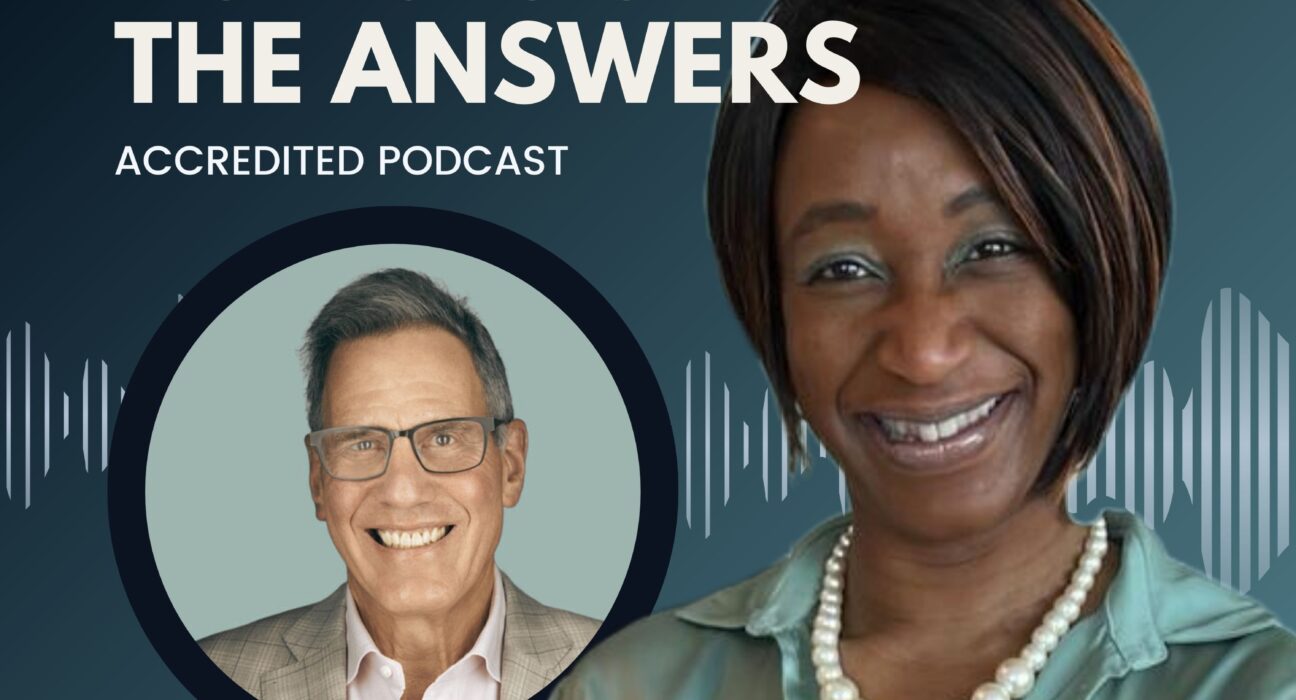
Dr. Richard Baron discusses the challenges facing primary care, emphasizing the need for well-resourced, team-based approaches. He highlights the importance of increasing investment in primary care to improve patient outcomes and reduce costs. Baron also supports focusing on Long COVID as a critical issue for future healthcare policy discussions.
Guest – Professor Richard J Baron
Note: The podcast has no bias. All conflicts of interest are highlighted with individual guests.
Healthcare Professionals | Earn 0.5 Certified Mainpro+® Credits! Please register/login to claim your CPD/ CEU credits.
Podcast Overview:
In this episode of “Long COVID – The Answers,” Dr. Richard Baron explores the strain on primary care, advocating for team-based models and better resource allocation. He discusses the need for increased investment in primary care and the importance of addressing Long COVID through comprehensive, patient-centered care.
- Primary Care Strain: The shift to virtual care has overloaded primary care doctors, who lack adequate resources and support.
- Team-Based Care: Emphasizing the need for multidisciplinary teams to manage complex cases and improve patient outcomes.
- Resource Allocation: The importance of health systems investing in primary care rather than solely focusing on high-revenue specialties.
- Preventive Measures: The role of vaccination and relationship-based care in preventing Long COVID.
- Policy Impact: The potential for policy changes to address Long COVID and improve primary care systems.
DISCLAIMER: The information in this podcast is provided for informational purposes only. You should not use any information discussed in this podcast and related materials to make medical or healthcare related decisions. Always consult a your physician or other qualified health care provider with regards to diagnosing managing your medical condition. Any medications or treatments, including any discussed in this podcast, should be initiated and managed by a qualified health care professional.
Podcast Transcript:
Healthcare Professionals: Please note to claim Certified CPD / CEU credits toward your medical license (Canada & reciprocal CPD/CEU Worldwide), you will need to register or log in.
Episode 8 – Primary Care and the Emergence of Long COVID ft. Richard J . Baron MD
[00:00:00] Funmi Okunola: The information in this podcast is provided for informational purposes only. You should not use any information discussed in this podcast and related materials to make medical or healthcare related decisions. Always consult your physician or other qualified healthcare provider with regards to diagnosing and managing your medical condition. Any medications or treatments, including any discussed in this podcast should be initiated and managed by a qualified healthcare professional.
Funmi Okunola: Welcome to Long Covid – The Answers. Today’s episode is entitled “Primary Care and the Emergence of Long Covid”. Today we’ll discuss how Long COVID could be managed in community medicine, namely primary care.
I’d like to introduce Dr. Richard J. Baron. Dr. Baron is the President and CEO of the American Board of Internal Medicine and the American Board of Internal Medicine Foundation. Dr. Baron received an English degree from Harvard College and his medical degree from Yale University. [00:01:00] He is a board certified internal and geriatric physician.
Dr. Baron has served as Group Director of Seamless Care Models at the Centers for Medicaid and Medicare Services Innovation Center, where he led efforts related to accountable care organizations and primary care. He was the architect of the Best Clinical and Administrative Practices Program, working with medical leadership of Medicaid health plans around the United States in learning collaboratives to improve the quality of care for their members, which reached more than half of the Medicaid population in the U.S.
He is a member of the Commonwealth Fund Advisory Group on Healthcare Delivery and System Reform and a member of the Aspen Institute Health Strategy Group, which promotes improvements in policy and practice by providing leadership on complex health issues. Dr. Baron has published many papers on the doctor-patient relationship, the falling trust of U.S. citizens in the medical establishment, better delivery of assessment and [00:02:00] management of chronic disease in primary care, and more recently, the impact of social media on the dissemination of medical information and how healthcare professionals can positively engage with patients through this new medium.
Welcome, Richard.
Richard Baron: Thanks, Funmi. It really is a pleasure to be here with you.
Funmi Okunola: Richard, do you have any conflicts of interest to declare?
Richard Baron: No, I don’t. I’m employed by the American Board of Internal Medicine and the ABIM Foundation, and that’s my sole professional engagement.
Funmi Okunola: Great. So, Long COVID has been described as the long tail of this pandemic with approximately 18 million people suffering from Long COVID in the U.S. alone, and anywhere between 100 million and 400 million worldwide. We’re looking at a vast burden of chronic disease on our healthcare systems. What approach do you feel needs to be taken to tackle this emerging healthcare crisis?
Richard Baron: Well [00:03:00] first of all, for me, thanks to you for focusing on this and for creating a community of listeners who are learning from you and the people that you bring on this program about how to think about a very, very difficult situation that I can really focus more on. What I think we’re going to need in the way of primary care capacity, which isn’t really different from primary care capacity to manage the whole host of chronic illnesses that are out there, and I think one of the things of course that distinguishes Long COVID is there’s so much more about it that we don’t know than what we do know.
I think it turns out not to be that different from many situations that primary care doctors face. So let me spend a couple of minutes on primary care and thinking about what it looks like to do that. Well, I think Barbara [00:04:00] Starfield was a scholar of primary care at Hopkins, and she talked about primary care as first contact care. She talked about it being affordable and accessible, and available, and those are all critical aspects of primary care that right now in this country we’re struggling to deliver. My own feeling is that the root cause of the problem is that we have, I sometimes say, under-theorized primary care.
What do I mean by that? When a gastroenterologist does a colonoscopy there are two revenue streams that flow from her doing that procedure. The first is a fee goes to her for her skill and expertise in actually doing the colonoscopy. But then there’s a whole other fee, which is actually substantially more, that [00:05:00] flows in what’s called a technical fee that covers the fact that she couldn’t have done the colonoscopy if she didn’t have a colonoscope, and a table, and a monitor, and an assistant, and cleaning the colonoscope.
So, we understand that in specialty practice, and we certainly understand it in surgical practice, that a surgeon collects a fee for doing a procedure, working in a room that is a bespoke design for him to work in, and he doesn’t pay rent and he isn’t paying the staff, but there are nurses handing him instruments that he didn’t buy. There they are. So, we realize in healthcare that for skilled clinicians to do what they do, they need an infrastructure in which to do it, or with which to do it, and I think in primary care we’ve really under theorized that infrastructure, that in the model we have of primary care, there’s only one [00:06:00] revenue stream – it goes to the doctor, and the doctor is assumed to be able to, out of that revenue stream, cover the various supports, that she needs to do the work that she’s got to do. That fee structure was set at a time when what it meant to be supported was somebody to answer the phone, somebody to send a bill, somebody to weigh and do a blood pressure on a patient and filing.
That’s kind of what the primary care office was. But now primary care is much more virtual. Every primary care doctor is managing an inbox that will include laboratory tests their patients have had, x-rays their patients have had, and consultations from subspecialists, and the specialty of primary care has not been supported to provide that [00:07:00] kind of responsiveness to patients. So, I think it is a problem with the payment system, not so much physician salaries, though primary care physician salaries are lower than other physician salaries, but I don’t think physicians aren’t going into primary care because of the salary. I think they’re not going into primary care because it’s a job they can’t do, and they can’t do it because they’re not resourced to do it in a successful way. If you said to the surgeon in the OR, “I’m sorry, the autoclave tech called in sick today, so you have to use yesterday’s tray”. The surgeon would say, “No way am I going to do that”! But every day primary care doctors come in and are told the MA called in sick, so you got to do your own weights and blood pressures today. It’s just not designed with the support needs in mind, and I really, really hope that will change.
Funmi Okunola: Excellent point, and I cheer that. I believe this approach with intent, Long [00:08:00] COVID could help change the face of primary care. With reference to a 2007 paper, The Patient Centered Medical Home, History, Seven Core Features, Evidence and Transformational Change published by the Robert Graham Center, and in your 2010, “How to Scale up Primary Care Transformation, What We Know and What We Need to Know” was published in the Journal of General Internal Medicine. You both talk about patient care being provided through a multi-disciplinary team, dependent on a deep understanding of the population served by the practice.
This is exactly the type of care needed for Long Haulers and the vast majority of Family Physicians working single handedly in practices dealing with a huge volume of patients with complex disease. How do you think this change can be facilitated?
Richard Baron: Well, I think you’re exactly right to focus on the team and the idea that we can’t have doctors doing this all by themselves. [00:09:00] We need to anticipate the kinds of demands that the patients are going to have when they reach out for care. So, it’s important. It’s something that patients now are going to want to communicate. For example, by email, if they can, and somebody needs to be prepared to realize that managing email is going to be part of what a primary care doctor does. In the current insurance reimbursement model not only is that not something that’s paid for, but the time that the doctor is spending doing that is time that the doctor is not spending doing things that are paid for, like face-to-face visits.
That’s another thing that patients will with Long COVID, and other patients will sometimes need to be seen when something changes so that the doctor needs to be physically [00:10:00] available, but the doctor also needs to be responding to phone calls and prescription refills that the patients may request, or the patients want to know – “I had a lab test what does it mean”? Explaining that either in a phone call or an email or a visit, the first two of those will not generate revenue for a primary care doctor. So, I think embedding the doctor in a team is the way that you’re more likely going to be able to respond to the needs that the patients have, and that the patients are entitled, that primary care system will respond to.
I think there’s an important change to talk about here that I don’t think gets as much attention as it should. Today in the United States, and these data are two or three years old, so it’s probably an even more dramatic number, but 73% of all doctors in the U. S. now work for organizations not controlled by doctors.
So, let’s think about what that [00:11:00] means. Fifty-two percent of those are hospitals and health systems that are employing these doctors. So, think about an academic health system that owns a bunch of community hospitals and owns a bunch of practices and owns a bunch of hospitals. In Philadelphia that could be the University of Pennsylvania health system that could be Jefferson.
The University of Pennsylvania Health System has over 10 billion a year in annual revenue. The staffing model for a primary care practice is not being set by the people who are paying for the care. It’s being set by the University of Pennsylvania Health System. They are the ones who are deciding what the staffing model in primary care is going to be.
Now, they have made a decision that they’re only going to operate primary care within the revenue line that they’re able to get from [00:12:00] insurance. They haven’t negotiated with insurance to make that revenue line much bigger because they’re trying to make the revenue line for joint replacements bigger or for organ transplantation bigger.
So, they’re not really negotiating for primary care, and then they’re not adequately resourcing the primary care practices that they operate. I think we need to focus more on the responsibility of health system leaders to allocate the resources needed to have a responsive primary care system, and inevitably to go back to where you started. That’s going to mean assuring that there’s a team of people responding to a predictable set of demands, and those demands are everything from telephone calls to emails to prescription refills to explaining imaging studies, laboratory results, or connecting dots for people, and it’s predictable. [00:13:00] We know that’s what patients are going to need, and I think health systems need to prepare themselves to resource primary care to meet that need.
Funmi Okunola: Yeah, so I fully endorse that as a practicing family physician. I worked as a First Nations family physician, which was fantastic, and what really worked there was that I had a team. So, I had public health nurses, I had community nurses, I had elders, I had social services, I even had access to occupational therapists. So, yeah, it was fantastic. I had my role as a doctor, but I could also rely on the team that went out in the community because we’re just seeing in such an impoverished community that there was a lot of complex illness.
That’s what we’re seeing in the primary care space, and obviously Long COVID sufferers are the same. So, we need those different people in the multi-disciplinary team, a social worker to explain the disability forms, 43 pages long, and for a Long Hauler that’s just [00:14:00] impossible when they have maybe sometimes not even 30 minutes of functioning capacity at the worse a day.
As a doctor, I had to bring people back five or more sessions to feel something like that, or an occupational therapist that would help with cognition. So, we need that for an elderly person who’s had a stroke and has cognitive disabilities. As would a Long Hauler who is suffering from brain fog, you need an OT to go out and help them with their psychological testing. We don’t have the time or the skills to do that as primary physicians, but all of this is dumped into our space with no resource and without the personnel.
As a practicing family physician, I see a lot of specialty care of patients transferred to primary care practice with little financial or educational support for primary care physicians. How can we involve specialists as part of the multi-disciplinary team effectively and help them to retain some form of responsibility for the more complex patients that they assess? [00:15:00]
Richard Baron: Right. So, I’ll go back to what I was saying before about the way in which increasingly healthcare is being delivered by what are referred to as “integrated delivery systems”, where in the kind of free market model of the first half of the 20th century in the U. S. everybody was an independent contractor – the radiologist, the surgeon, the anesthesiologist, they all worked for themselves, and then the patients were kind of passed from one to the other. Now we have a lot more corporate consolidation.
We have a lot more ownership of practices by entities. Now the practice you were describing in the First Nation setting seems like an absolutely ideal practice. So, the idea that one organization owns and controls [00:16:00] multiple pieces of healthcare can be a really positive thing, and I think when you see it, as you saw it, and as you experienced it, you had a group of people. The very first leadership job I had was the Medical Director of a startup Medicaid HMO, and nobody really knew what a Medicaid HMO was, but we believe the mission of our organization was improving the health of a defined population within a fixed budget.
With that combination of having financial accountability, you only have the resources that you have, and health accountability outcomes accountability for the patients for whom you are caring. You saw that put together in your First Nations setting, and that was a group of people who understood that the resources they had were meant to make this community healthier.
But we don’t have very [00:17:00] many academic health systems in the U. S. or integrated delivery systems in the U. S. who have, as they’re really owning the mission of, we’re trying to make the community in which we operate a healthier community because if that was the outcome that they were spending the money for, they would spend it differently, and there would be huge potential for them to make resource allocation decisions that would create, in your practice as a family physician, the same kind of surrounding resources that you experienced in the First Nations setting, that it’s a matter of what are they investing in and why, what are they resourcing and why?
I think as clinicians operating in systems like that, we need to get better at asking that question because certainly when I preset medical students at Penn here in Philadelphia doing a root cause analysis [00:18:00] of why diabetes care wasn’t very good, they talked to the doctors who said the Insurance Companies don’t pay enough for the care that we do.
Well, my response to that was, “Wait a minute. It’s not the Insurance Companies who are signing your paychecks. It’s not the Insurance Companies who are deciding your staffing model, and by the way, when you came into the building and there was a security guard there, that wasn’t on the fee schedule either”.
Somebody here made a decision. We need a security guard. We need clean bathrooms. We need a janitorial staff. We need whatever it is to operate safely and effectively as a healthcare delivery system, and we need to start holding people accountable for the decisions they’re making on the delivery system side.
Funmi Okunola: I totally endorse that. In many studies it has been shown that having a family physician who is a usual source of healthcare, who knows you, results in greater access to [00:19:00] care for disadvantaged groups, reduces hospitalizations. Lower spending on specialist services results in better quality of life and reduced death, i.e. improving health outcomes for the whole population. In the UK and North America less than 10% of health care spending goes into primary care medicine. How do we elevate the status of primary care so that it is adequately funded and enabled to continue to perform on these outcomes?
Richard Baron: You have asked perhaps the most important question in American health care today, and maybe in health care anywhere.
You say 5 to 10% in the U. S. – it’s 5%. In the U. K. it’s 10% which is twice as much as 5%, which is a start, but it may not be as far as it should go. I think that I worked for a couple of years, (you mentioned it at the beginning of our conversation), at the Innovation Center focusing at CMS, focusing on new models of [00:20:00] primary care, and we were able to field a model that we got the Office of Management and Budget to sign off on which put 40% more gross revenue into primary care than goes there now. Forty percent more and we got 42 Insurance Companies around the country to agree to offer a parallel increased investment in primary care. What was the story we had to tell to persuade them to do that? The answer to that question is we had to say, you know what, when you have bad primary care, when you have inadequate, inaccessible, under- resourced primary care, what happens is you have the most expensive care you could have with the worst outcomes because it’s uncoordinated. It’s specialty care.
You’ll get specialists doing all the procedures that they can do before they pass the patient on to somebody else to do more procedures, [00:21:00] and if you are responsible for the health and expenditures of a population, then you wind up investing in primary care as a business strategy. You do it because it makes you more successful as a delivery system because you’re able to, for whatever you’re spending, you’re going to get better health outcomes across the community if you’re investing more in pre-care.
So how do we get there? Well partly I think doing at-risk contracting where health systems are instead of being paid for every procedure they do, are basically given a portion of an insurance premium for a population of patients, and they’re told to do what we were trying to do at that Medicaid HMO all these years ago, improve the health of a defined population within a fixed budget.
They’re closest to it. They know how to do it. They need [00:22:00] to take on that responsibility. So, I think risk-based contracting, enlightened management, and primary care doctors, explaining that the services they are providing are services that patients need, that patients want, that yield better outcomes, and if the healthcare delivery system is serious about taking good care of their patients, they need to make serious investments in primary care.
Funmi Okunola: Excellent answer. Prevention is key when it comes to managing complex diseases like Long COVID or others like diabetes, whatever. The primary goal of our healthcare systems at the moment seems to be the treatment of disease. How do we prevent people from getting sick from Long COVID for example, in primary care?
Richard Baron: Well, uh, certainly. Doing everything we can to try to be sure that the people we care for are maintaining high levels of current [00:23:00] immunization seems to reduce risk of getting COVID and Long COVID, and of course, it doesn’t make it zero, and people will still have breakthrough infections no matter how current they are in their vaccination.
But I think vaccination is a proven preventive strategy, and we need to be sure we’re doing that well. Then I think as we learn more about Long COVID and as we learn more about what kinds of things that can be effective, we’re going to want vehicles for disseminating that are trustworthy vehicles, and that involves relationship-based care that involves doctors and patients connecting in meaningful ways where the patients know the doctors and the doctors know the patients.
I think we can build systems that do that. But if we don’t have those systems, then people bounce around, and they get something here until it runs [00:24:00] out, and then they get something there until it runs out. I remember when our kids went from primary school to junior high school or middle school, the teacher, the primary school teacher said in primary school, we teach students. She said in secondary school, they teach subjects, and I often thought about that as primary care doctors take care of patients, and other people in the delivery system are much more likely to be taking care of diseases or conditions orfixing broken body parts. It’s worthy work. It’s critical work. It really helps people, but it’s not… It’s a different kind of work than primary care doctors do of really trying to look at the whole person and the whole picture and really try to do what we can to help people live the highest functioning most flourishing life they can.
Funmi Okunola: We’re practically out of time. I’m going to squeeze one [00:25:00] last question in. The Aspen Policy Strategy promotes improvements in policy and practice by providing leadership on complex health issues. This can have a role in how the U. S. government makes changes. You’re a member of the Aspen Policy Strategy Institute. As a member, are you aware of any plans by the Institute to assess Long COVID in this way?
Richard Baron: The short answer to that is “I’m not”. The group talks each year about what the focus for that year is going to be. The group has focused on gun violence, the group has focused on opioids. The group is focused on maternal health outcomes. In each of those areas, it’s made some succinct recommendations for each area. What it would look like to do things better? As a member, I do have the ability to propose topics to be considered, and Long COVID is something that I’d be happy to propose because I think you’re right.
It is clearly the tail of the [00:26:00] pandemic. It’s going to be with us for years, and we’re going to need to understand so much more about it than we do now.
Funmi Okunola: Thank you. So thank you, Dr. Baron for joining us today, and for another wonderful, thoughtful and insightful interview.
Richard Baron: Well, again, I admire your leadership Funmi and thanks for taking this on. Your patients are lucky that you’re there, and I’m glad to be part of the conversation that you’re having with a community that needs reliable and trustworthy conversations.
Funmi Okunola: Thank you. Please join us next week for another episode of Long COVID – The Answers. [00:27:00]
Funmi Okunola: Some questions for listeners to consider.
What are your top five takeaways from this episode?
How will this episode change your practice or perception of this disease?
What will you do to act on what you’ve learned?
Please discuss your thoughts on our social media outlets such as Twitter or X, our website blog, Instagram, Facebook, LinkedIn.
Please rate this episode.
SHOW NOTES:
Dr Richard J. Baron MD – President and CEO of the American Board of Internal Medicine and the American Board of Internal Medicine Foundation, talks to Dr Funmi
Okunola about how Primary Care needs to adapt to provide medical services for Long COVID and other forms of chronic disease.
1. The Patient Centered Medical Home, History, Seven Core Features, Evidence and
Transformational Change – Published by the Robert Graham Center, 2007








